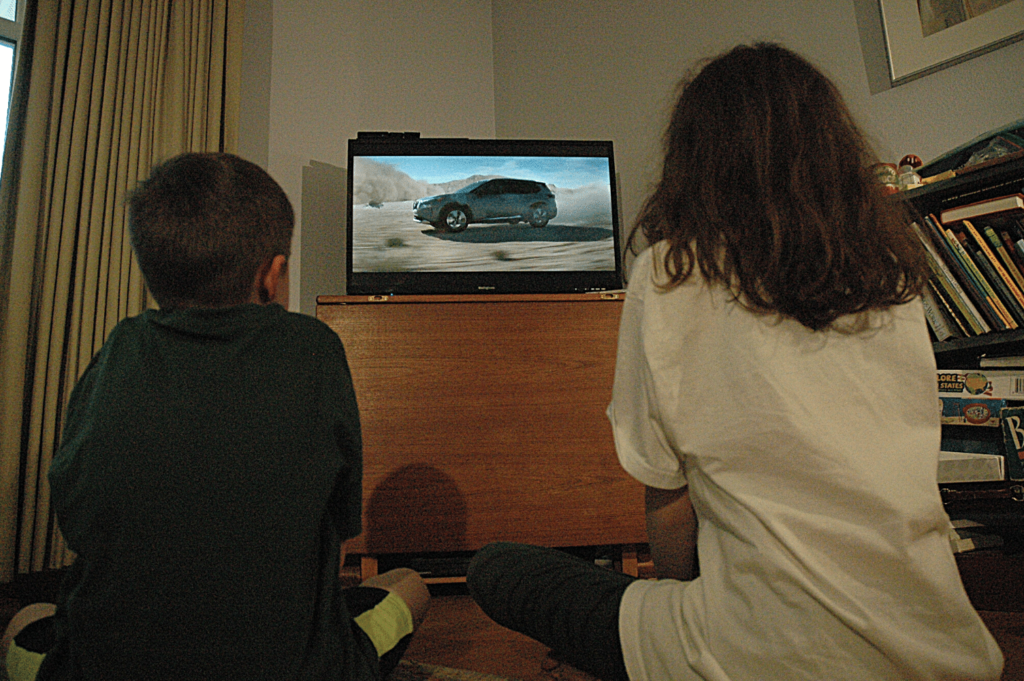This post was last updated on July 13th, 2022 at 09:51 am
When each of our two children reached about 5 years old, we started talking to them about ads. It’s an ongoing conversation designed to inspire our kids to think critically about how ads seek to influence them. We want our kids to be able to see through the selling techniques, but we don’t expect them to learn this on their own.
It’s important to talk to children about advertising because it’s everywhere nowadays thanks to mobile devices. Many Americans see thousands of ads each day (yes, thousands). To send kids into this environment without giving them the tools to resist advertising’s influence is a recipe for debt accumulation and over-consumption, two enemies of the frugalmatic lifestyle. As a parent, I feel an obligation to have these conversations because, let’s face it, many kids aren’t receiving this education in school.
So when is the best time to talk kids about ads? I suggest whenever the family gathers to watch TV. We’ve had in-depth discussions during “Brady Bunch” reruns, Packer games, news programs, and holiday specials. Of course, you can also talk about ads that appear on YouTube and other internet streaming services.
Questions to ask your kids
I prefer to ask a lot of questions and often use them to steer the conversation toward the “moral of the story.” You might try asking some of these questions:
- How is this ad trying to make you feel about the product?
- Are any parts of this ad not true? Which parts?
- What do you think it would be like to own this (fill in product name)?
Some of our best discussions have happened over commercials for products our kids are familiar with but don’t necessarily want for themselves. Vehicle commercials, in particular, are well suited for discussing selling techniques.
Kids know what a vehicle is and how it’s used. However, they’re not emotionally attached to vehicles (ours aren’t, anyway), which allows them to discuss vehicle commercials more objectively than, say, toy commercials. Also, many vehicle commercials blatantly appeal to a sense of adventure, often by showing vehicles driving through exotic terrains. Kids can more easily identify these exaggerations because their experience riding in vehicles is comparatively mundane.
A recent Nissan Rogue ad is typical. It shows a family driving on an Average Joe road when they “suddenly” get inspired to race across an icy tundra. With a click of a button, they’re flying past penguins. The message is simple, “Buy this car, and you will have adventures like this.”
Identify exaggerations and outright lies
Here’s how a conversation about this ad might go:
Parent: “What happened in this ad that couldn’t happen in real life?”
Child: “They were driving on a regular road and then all of sudden started driving by a bunch of penguins. And, the kids and parents are in fancy outfits that keep changing.”
Parent: “What about when the driver turns that dial next to his seat?”
Child: “It takes them to different places, like to Antarctica.”
Parent: “How is this ad trying to make you feel about the car?”
Child: “That it’s exciting to have one. If you get it, you can travel to these cool places and see penguins.”
No matter how our kids answer the questions, I inevitably make the point (while trying not to lecture too much) that ads are littered with exaggerations and even lies. I also don’t assume that what appears to be an exaggeration to adults necessarily registers as an exaggeration to kids. State-of-the-art special effects can blur the lines between reality and fantasy for small children.
Turn predatory ads into learning opportunities
Televised sporting events offer great opportunities to talk to kids about ads. If your children are like ours, they’re likely more interested in watching the commercials than the games. Sports ads are also a good place to identify marketing of products linked to risky behaviors, in particular ads for alcohol and sports betting. Sports betting commercials are a relatively new phenomenon in the U.S. and surged with the 2018 U.S. Supreme Court decision legalizing sports betting in all states.
What was once considered a shady enterprise is now being promoted as mainstream entertainment. Some sportscasters and commentators have started talking about gambling like it is part of the game itself. Meanwhile, the sports betting industry is at work portraying itself as responsible—recently releasing a “marketing code.” It’s a long but relatively-toothless document that’s done little to curb the tsunami of sports betting ads.
We’re in the Wild West phase of sports betting, and you can bet (pun intended) the result will be a financial disaster for many people. The 2018 Supreme Court decision will come back to haunt sports fans who confuse sports betting for an innocent form of entertainment.
When a betting ad appears on TV, I flag it and work to turn its predatory message into an educational one. We talk about what the ad is trying to get you to do—to throw away your money on guessing the outcome of sporting events. And, I explain that the gambling companies make money by having you lose your money. The ads want you to believe you’ll win when, in reality, chances are you’ll lose.
Read: How to help your children steer clear of sports betting addiction
Toy commercials can be tricky to discuss
Of course, not all of our conversations involve such weighty topics. We also talk about advertising during children’s programming. Interestingly, our conversations during children’s programming are often shorter and less engaging than during other types of programming. I think this happens for a couple reasons. For one, it’s harder to hold a discussion without losing children’s attention once a show resumes after a commercial break.
Also, it’s more difficult to objectively evaluate and grasp the manipulative effects of commercials related to products you already like or want. We discuss toy commercials, but if our kids want the toy on the screen, they don’t necessarily see the depiction of the toy as an exaggeration. While an SUV riding off-road alongside penguins appears ridiculous, images of children experiencing elation over a toy don’t seem far-fetched.
Nevertheless, it’s important to discuss toy ads, especially because children are the target and susceptible to the messaging. During these discussions, don’t become frustrated if your children appear to agree wholeheartedly with an ad. Your lessons will sink in over time, especially if you continue them over a long period.

Talk about ads today to prevent conflicts tomorrow
It’s a fair question to ask: Do these discussions have any effect? Why should parents bother turning TV time into a Q & A on advertising strategies?
There’s not a lot a research on whether parental interventions mitigate advertising’s effects, though evidence suggests the talks can be fruitful. A 2005 study surveying elementary school children in the Netherlands and their parents found discussing ads with children reduced parent-children conflicts over purchases and helped foster less materialistic views among children.
“Our results indicate that parents are able to counteract the effects of advertising by talking with their children about advertising and consumer matters,” the study concludes.
As the study notes, parents pay the price for their children’s inability to see an ad for the manipulative marketing tool that it is. Advertisers use kids to pressure parents to buy them stuff. It’s annoying, at best, and, at worst, leads to hard-earned dollars being wasted.
The nuts and bolts of ad persuasion
If parents don’t teach their kids how to defend themselves against ads, it’s likely no one will. I consider myself fortunate to have been taught about ads in middle school, in a business class. It was a revelation. Back then, I even had dreams of someday becoming an advertising manager. I can still remember the teacher discussing the different types of ad appeals.
Bandwagon appeal: Making you believe everybody is using a certain product (McDonald’s: Over 99 billion served).
Fear appeal: Frightening you into thinking you need to get a certain product to prevent a bad outcome (Pretty much any political ad).
Endorsement appeal: Using seemingly trustworthy celebrities to vouch for a product (Tom Selleck is now promoting reverse mortgages).
Emotional appeal: Persuading you to feel a certain way so you’ll buy a product or make a donation (Think Coca-Cola’s “I’d like to teach the world to sing” ad).
Rational appeal: Making the logical case for buying a product. (“Bounty is 2x more absorbent so you can use less.”)
There are more, but all others, such as music appeal and sex appeal, arguably stem from one of the five listed above.
It’s not necessary to teach these types of appeals to elementary-age kids, but it’s good for parents to know them. Understanding which appeal an ad is using can help parents ask better questions. For example, an ad showing a large group of kids having fun with a toy—bandwagon appeal—could prompt a comment like this: “Wow, how is this ad trying to make you feel if you don’t have that toy?”
Why watching some commercial TV is a good thing
Some parents might respond to this post by saying they don’t allow their kids to watch commercial TV. I can appreciate the desire to shield kids from commercials by allowing them to watch shows only on commercial-free platforms, such as Netflix.
But if you want to prepare your kids for entering an advertisement-cluttered world, now is the time to introduce them to commercial programming, either on TV or the internet. Watch it with them and talk about the ads, so that someday they become vigilant and informed consumers.
The frugalmatic lifestyle is fundamentally a skeptical one. You’re on guard against schemes and messages geared toward getting you to waste your time and money, or even to undermine your own health. While it might sound cynical, the vast majority of products promoted in ads qualify as “wants,” not “needs.” And as with the case of sports betting ads, some ads promote destructive behavior.
As parents, we should include our children in our frugalmatic journey. It helps set the tone for the household and turns a passive experience like watching TV into an active, purposeful one.

